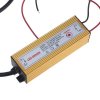alesh
Well-Known Member
@SupraSPL Can you be a little more specific about different Vf's please? I've measured a few dozens single die Cree LEDs and the differences were a few hundreths of Volt. Since in 3070 there's a lot of dies and they have to be exactly same Vf, I can imagine it could add up to around 3-4V?? Just a guess, correct me please.
Do you know of any driver with PWM dimming which actually does PWM dimming? I mean, MW drivers for example, do accept PWM input. However they reduce output according to duty cycle. Yea it's more efficient for human vision application. But IIRC knna stated that true PWM output could be beneficial even with the loses from higher current. And remember that he used Luxeons K2's and then Golden Dragons. These COBs nowadays are much more tolerant in terms of high current and temperature. Perhaps this could be a way to achieve even greater results.
Do you know of any driver with PWM dimming which actually does PWM dimming? I mean, MW drivers for example, do accept PWM input. However they reduce output according to duty cycle. Yea it's more efficient for human vision application. But IIRC knna stated that true PWM output could be beneficial even with the loses from higher current. And remember that he used Luxeons K2's and then Golden Dragons. These COBs nowadays are much more tolerant in terms of high current and temperature. Perhaps this could be a way to achieve even greater results.

 ).
).








